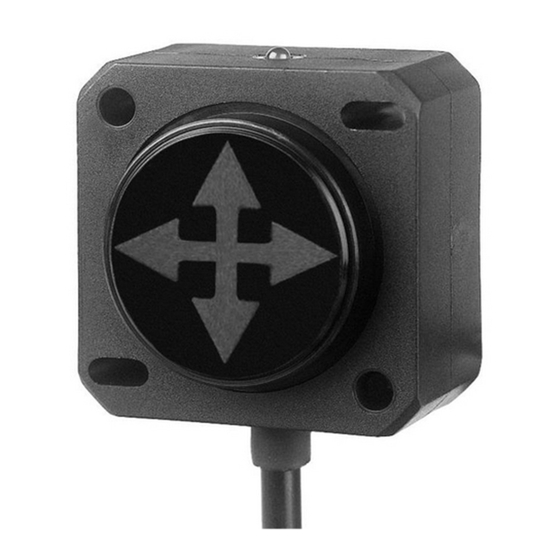DIS Sensors QG40N Benutzer- und Sicherheitshandbuch - Seite 4
Blättern Sie online oder laden Sie pdf Benutzer- und Sicherheitshandbuch für Schalter DIS Sensors QG40N herunter. DIS Sensors QG40N 6 Seiten. Tilt/acceleration switch (sil1 plc)
Auch für DIS Sensors QG40N: Benutzerhandbuch (5 seiten), Benutzerhandbuch (15 seiten)

QG40N Tilt SIL1 PLc
User Safety Manual v1.3
Hardware setup
8
Connection:
Default:
5-pins M12 connector male (A-coding). See datasheets for details
Optional:
Cable with open ended wires. See datasheets for details
EMC / CE
9
See separate 'Declaration of Conformity'
10 Signal processing
The signal processing consist of several aspect, addressed below.
10.1
Sample rate and averaging
Tilt switch sensor:
The internal g-sensor chip is sampled every 10ms. Each sample of the element consists of 16 samples for each axis.
Resulting in sample rate of 1600 Hz. These samples are input for a 32 tabs FIR input low pass filter. Each 10ms new data is
available for the µC.
A decimating filter reduces the refresh rate by 4x, so refresh rate is 40ms
This decimating filter is averaging the values during the 40ms refresh rate (4 samples averaging)
Acceleration switch sensor:
The internal g-sensor chip is sampled every 5ms. Each sample of the element consists of 16 samples for each axis. Resulting
in sample rate of 3200 Hz. Each sample is checked over the measuring interval. At the end of the measuring interval the
acceleration value is compared to the programmed switch points and the switching outputs are set accordingly, refresh rate
40ms.
10.2
Output filter:
Tilt switch sensor:
The output of the sensor can be extra filtered by a 1
Via the optional 'QG40N configurator' a -3dB frequency or RC-time can be configured.
A longer low-pass filter time results is a smaller bandwidth and therefore a more stable output signal (less noise), but also
more phase delay.
Acceleration switch sensor:
Not applicable
10.3
Zeroing
To eliminate mechanical offsets a zeroing actions can be performed.
st
During the 1
minute after power up the zeroing input is sensitive for a zeroing action.
Sequence:
1.
Left input unconnected during power up for at least 0.5s
2.
Switched/connect input to Gnd for at least 0.5s
3.
Left unconnected again
4.
Result: The sensor will set the current inclination position as 0°. The actual zeroing point is where the input changes
from Gnd to unconnected.
The maximum zeroing-range is specified in the datasheet. Horizontal mounting sensors have zeroing-range-limit of ±5°,
vertical mounting sensor can be zero-ed over full 360°.
The new 0° value will be stored in non-volatile memory (EEPROM)
page 4 of 6
st
order low-pass filter. Default this output filter is disabled.
4
